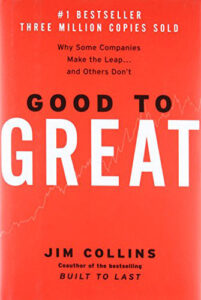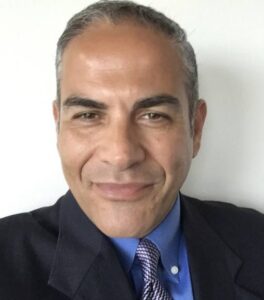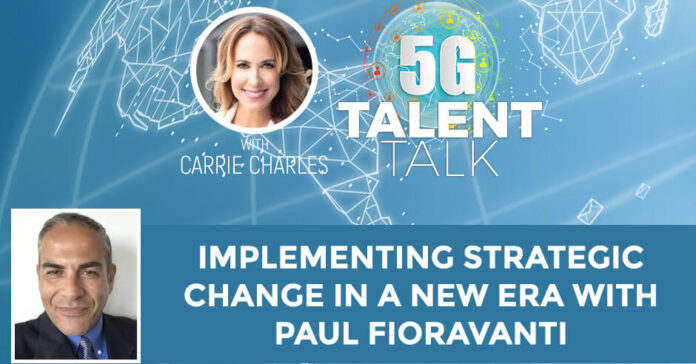With the rapid development of technology comes the need for strategic change. Businesses must be able to handle rising demands and changing customer behavior. Despite the many adjustments, one thing remains a constant: human capital must never be taken for granted. Joining Carrie Charles is the CEO and Managing Partner of QORVAL Partners, Paul Fioravanti. He shares his insights on helping telecommunication clients meet the expectations of the digital future. Paul explains how high profitability and a good business reputation can be achieved by building relationships, keeping a healthy workplace culture, and making your employees feel valued.
—
Watch the episode here:
Listen to the podcast here
Implementing Strategic Change in a New Era with Paul Fioravanti
I am super excited to have Paul Fioravanti with me. He’s the CEO and Managing Partner of QORVAL Partners. Paul, thank you so much for joining me.
Thank you for having me. It’s a pleasure to be here, Carrie.
I want to hear more about QORVAL Partners, your services, and what you do. I’m so excited that you are here because so many people need to hear this message.
The quick story of QORVAL Partners is that the firm was begun several years ago in Tampa by my late partner Jim Malone. Jim passed away in 2021. Unfortunately, we lost him, but we have not lost the shadow of his great leadership. Jim is the only person that I’m aware of that ever was the CEO of six Fortune 500 companies in six different industries.
The amazing thing about Jim is his humility. He was a super guy and helped so many people, not with business lessons but with life lessons. I was thankful to begin working with Jim several years ago. I don’t like the phrase boutique firm, but we are a smaller management consulting and advisory firm. We have got about 35 subject matter experts that work in a range of different capabilities as interim managers, whether they be CEO, CFO, COO roles or other subject matter expertise areas such as IT, human resources, leadership training or cybersecurity. There is a mix of business challenges that even smaller businesses are facing.
In terms of my involvement, I have been involved in about 70 situations in about 35 industries. One of the things that you learn when you have had that broad experience is that every industry thinks that it’s unique and special, but there are a lot more common denominator issues that affect businesses. Even size-wise, sometimes it’s easier to fix a larger business than a smaller one.
I thought that was interesting and this is one of the reasons why I wanted to have you on the show because you work in so many different industries. I know that it’s valuable for leaders to get insights from different industries to pull that into telecom, but I do know that you have also served a lot of clients in the telecom space. Who is your typical telecom client?
Most of the work that we do is in 2 verticals or 2 areas. One is manufacturing and the other is services. In the services realm, we have probably worked on 25 or 30 trade contractors with almost half of them being telecom, wireless or related communications contractors. To answer your question, most commonly, it’s a contractor that hits a certain size plateau.
Fixed costs are the enemy of profitability.
For example, there could be a contractor that’s profitable at $1 million or $2 million in revenue. They scale up to ten, they start to have problems. They go from say, $12 million or $15 million up to $30 million in revenue. They start to have issues. What happens is the contractors get lost along the way, and sometimes the business, the clients and the people, even the managers that get you to a certain level, are not the people that will get you to the next level.
The challenges that typically emerge in the telecom contracting space. The number one is very thin margin work and the contractors not truly knowing what their cost structure is. There’s a temptation to fall into the idea of bidding a job on gross margin. For example, we have an article about it. It’s called the Gross Margin Trap, but the idea is that it was a telecom job and the project manager said, “We did the job for $10,000. Our cost is $6,000 but we made $4,000.”
He forgot about the other half of the income statement where below direct and indirect in materials costs, you have things like company overhead, insurance and those sorts of things. The greatest thing that a contractor can do to ensure profitability is to manage the relationship between fixed costs and variable costs.
One of my sayings is always, “A fixed cost is the enemy of profitability.” When a contractor grows and their customer is telling them, “You guys need to ramp up because we have all this work for you,” and go out and hire people and buy trucks and all that stuff. That’s a very tricky spot to be in and without good job costing, they can find themselves going down a rabbit hole.
That’s why sometimes we will suggest to our clients to use contractors, so they don’t have those fixed costs. At least, they are temporary. You talked a little bit about the problems that you solve. Can you maybe discuss a case study or a success story or two from your telecom clients?
Candidly, there are many more challenging situations where the telecom contractor maybe has gotten off track with profitability. One particular company comes to mind and to put it in terms of impactful numbers, we were called in at a point in time where they had grown significantly year over year, but their controls had gotten so bad that they were lost in the weeds.
I remember the numbers and this was in 2016. Year over year, the company went from $24 million to $32 million in revenue. They did an additional $7 million to $8 million in revenue. What we did was we isolated the additional work that they did during that period. We broke it down and looked at it as if that was like an individual P&L income statement.
What we found was that after doing almost $8 million in revenue, there was a $1,700 profit contribution. That tells you that all that additional business was a distraction. The challenge the company had was it started throwing resources at problems. What we like to do is what I call the 3Ms, Map, Measure and Modify.
Map out what’s happening. Measure, output, production and margin. What are the KPIs of your business? If it’s not measurable, it is not a KPI. In the case of this company, their idea was, “We are going to get the latest software. We are going to have project management software. We are going to have a progress tracking software.” They started with QuickBooks, which worked fine and they went with another platform, Timberline or Sage that they could not support.

They started adding all these technologies, software platforms and everything. They lost sight. It was like flying a plane in the dark with no lights in the instrument panel. They had no idea where they were and where the horizon was. That’s a pretty common problem with companies as they grow is they don’t understand.
The two most important things in business are dollar sources and dollar uses. You need to know where they were coming from, and you need to know where the money is going. It’s basic as that sounds. I was a CEO of a $350 million pharma company for a year and turn that around. This was run by pharma veterans and they were losing money. They had no idea on $30 million a month, how they would make money. It’s not always industry experience or hiring the people that check the box. It’s the hard work and the grind of getting in the trenches and looking at the margin and data. Understanding where you are making money and where you are generating losses is so critical.
You do quite a few turnarounds in your work, right?
Yes, we do. Most of our practices are turnaround or restructuring, but we focus on what I call the three its of why people hire us. It’s to grow it, fix it and exit. Those are typically things that are motivated by the need to make a change. It’s a transformational plateau or it’s a point in time where the company has an event. There’s usually a significant emotional or focusing event that happens.
It might be the accountant did the year-end financials and said, “You guys are bleeding,” or it may be that they run out of cash, which happens fairly frequently. There was something that motivates needing to make a change and they needed to either grow, fix or, in many cases, exit and exits can be great. They can be very profitable and opportunistic. Sometimes they, unfortunately, are motivated by the need to get out because a bank or lender is pressuring them. Maybe they violated a borrowing covenant. There’s some variable that is motivating them to make a change and seek an exit.
What are some common mistakes that you see companies make or leaders make? There’s probably a very long list and not just necessarily in telecom, but in general. You start working with a company and you say, “I have seen this one hundred times.”
One mistake that we try not to fall into is even if it looks like a situation that we have seen before, we can’t typecast it and generalize because there are no two situations that are alike. What we do is what the company should do and that is collect objective data and look at what’s happening in the business. I would say a common trap that businesses fall into is they think that as they are growing that it will solve a multitude of sins, but the truth is that growth consumes cash. It costs money to grow and a lot of businesses don’t realize that.
We have worked with four companies that have been on Shark Tank in one-way, shape or form. They either were turned down or somewhere in the middle. As they are growing, it’s one thing to get an initial capital investment or for any business to get an initial line of credit or something, but there are times when you hit a wall on growth. In this industry, in telecom, it’s very tempting to run out and hire all your friends and hire everybody you know.
People are not motivated exclusively by money. Many well-paid people leave jobs for other reasons other than poor compensation.
Time and again, I have seen this play of, “Frank is the project manager and Joe is the engineering guy. We’re going to bring him aboard and he’s only looking for X. e needs a new truck and he’s going to bring all this work with him. He’s got the relationship with Carrie over here.” That usually does not happen, which leads us to the concept of the cultural challenges of the industry.
I have run several specialty contracting companies, either as a COO or a CEO, everything from pharmaceuticals to manufacturing, but several companies in the construction and services space. What’s unique about telecom and wireless is it’s got an industry culture that is very challenging compared to other industries. If you talk with anybody that works in multiple verticals, telecom communications, utility services, power plant energy, in general, and renewables, each one of those verticals has a discrete and distinct culture, but wireless is certainly an interesting one, to say the least.
Could you go a little deeper there and what does make it different?
If you go back to the evolution of the industry, when you think about some of the early companies that were putting cell towers up in the late-‘80s, you think back to companies like Metro Mobile and Bell Atlantic. They were some of the early companies. Even some of the TowerCos like Crown, those companies had very different income statements and different margins at the time.
You could put up a cell tower. If you are a contractor, you’re making a lot of money at that time. Even on the engineering side, a set of drawings was maybe $8,000 and then a couple of years later, you were allowed $1,750. The margins got tighter and there was upward pressure on the cost of being in business.
In certain Northeastern states, the worker’s comp insurance premiums, general liability, excess liability, and now other things they have added on like cybersecurity, employment practices and liability. The cost of doing business has gone up. The margins have come down and it’s made the industry very challenging because, with reverse auction pricing, matrix pricing and all the things going on in the industry, it makes it very difficult to make any money if you do not have control over every single penny and dollar.
I think your business is the future because, in the industry, they have learned that flexible staffing is the key. What I said earlier, “A fixed cost is the enemy of margin.” I have always felt that the ideal business model in the wireless contracting or wireless communications infrastructure space is to have flexible staffing. What companies don’t do enough of and we have seen this time and again, is they do not develop relationships at a higher level in the organization.

For example, if I’m running a contract to the co, I’m at the mercy of the market manager and God only knows who’s knocking on his door and what they are offering him. It’s an interesting industry from that perspective, but our advice to clients is always to elevate your relationship in the organization. For example, if a contractor is working for Verizon and they have never presented to Verizon corporate or if they are working for Ericsson and they don’t even know where Plano, Texas is and have never been there, that’s a problem.
That’s a ticking time bomb because they don’t have that air cover in the business relationship and you should do that in any industry. You should always elevate the level of your relationship. Beyond that, a common trap that contractors will fall into is they will get behind paying their subs. The next thing you know the sub is knocking on the door of the GC, TowerCo or turf vendor.
Once you have eroded that reputation, you are on a slippery slope. Again, there’s always another guy that’s willing to come along and take the work from you. There is not a lot of loyalty. It’s a thin margin business, cost controls and management controls in these companies are typically not great. As they are big or even, in some cases public, it does not mean they are good. It just means they are big.
We have all heard this Peter Drucker quote for years, “Culture eats strategy for breakfast.” The one that I learned from Jim is, “Culture is the worst behavior that you tolerate in an organization,” and that happens at any level. If it’s executive behavior or if it’s lower-level employee behavior, what’s the worst thing that you do that’s acceptable? Whether it’s the service you provide or it’s something that happens internally to the organization, that’s your common denominator. That’s your baseline for what sets the company culture and what sets the tone.
I have a company and 80% of my people are engaged and connected and passionate about the company, and then I have got 10% that are medium and 10% that are disengaged. That 10% is who I need to pay attention to and I have to elevate that 10%, right?
Correct and some of them may not make the trip. Some of them are not on what we call the traveling team. There are a lot of variables that form people and how they behave in organizations. It’s like you have this culture that you enforce in your organization and that you cultivate. You are trying to take care of your people so that they are loyal to you. It’s a retention tool that most of all, they are happy. It’s a profitable experience for them to be there. Maybe there are some shares. There is an ESOP plan, profit-sharing or something. There’s a reason why they want to stick around presumably.
The challenge with that now is loyalty is in short supply. I’m not sure how it correlates to the pandemic. I have heard about the Great Resignation and everything else like everybody else has, but I don’t understand it and the question remains, “Where are they going?” There’s a churn and there’s a reason that people are not sticking, but that’s not necessarily bad because if they are not the right people in the role, then they shouldn’t be there.
One of the books we always recommend is Jim Collins’s Good to Great. You have heard this story about the right people in the right seats on the right bus. That is an independent variable of the outcome of culture. If you are bringing the right people into the organization, there is collective learning and development that happens.
The assumption of that is that the organization should get better. They should be better at managing stakeholders. Their organizational clients are stakeholders. If you are falling on your face constantly with Ericsson, Nokia, Black & Veatch, Verizon, AT&T, and whoever it is, then there’s something seriously wrong, and you have to take that feedback.
If you are doing your job right as a senior executive, you’re doing a lot more listening than talking.
Sometimes it’s as simple as a high-level connection between the CEO of the contracting company and the highest level that they can get to within the customer relationship to say, “Can we meet and can you tell me what we can do better?” I was in a situation where this was a Massachusetts wireless contractor that was probably one of the worst managed companies I have ever seen. We had to go to the client and ask them what we had not built. We found out that we missed almost $1.5 million in billing.
That’s pretty embarrassing when your client tells you that. “I know you guys are struggling financially, but maybe you should bill the $1.5 million that we owe you.” It happens all the time. I don’t mean to be critical of the industry because every industry and manager can get better. We can all get better at what we do. Again, it’s what culture is tolerated in this idea that, “That’s the way we have always done it or that’s the way the industry works.” There’s always an opportunity to change it.
I have a quick story. In doing the pharma turnaround, we had a site in Puerto Rico that was a legacy Merck site and the employees there were struggling because the future of the site was uncertain. It was only operating at 25% or 30% capacity. What I saw a solution to be was, “Let’s get more volume.” We are manufacturing a product for Merck. Let’s go to Merck, sit down with the senior manager and say, “This site is not sustainable at the current volume. If you can give us a larger share of global volume then, we will be more efficient with the way we operate and you still have a supplier. We are still in business. We keep all the employees. We operate and we are profitable and sustainable.”
The sustainability issue is a critical one because, if a business is not operating properly, then that’s a downstream risk of all the way up to the TowerCo or the turf vendor because they don’t want those contractors and materials vendors coming back saying, “I was never paid or the company goes out of business.” That’s too much of a risk to bear.
You mentioned the telecom industry and telecom companies and how challenging it is. To me, the great ones will rise above and they will stand out. The companies that know how to manage and succeed in this climate that we are in, which is very different, like you said, than it was even years ago. I feel like they will rise to the top.
I wanted to go in a little bit deeper into the workforce challenges that you are seeing with your clients. We know there are not enough people and there are retention issues. Everybody wants more money and there are so many challenges, but what are you seeing when you go into a company that is some common challenges that leaders are going through right now? Also, what are you recommending to them? What strategies?
It’s a question that cuts across all industries and the question that cuts across all-size organizations. If data has shown us anything, it’s that people are not motivated exclusively by money because there are many well-paid people that leave jobs for some other reason. You have to dig down into, what do people like and not like about the organization? Retention comes in many forms and flavors. In some cases, it’s some a share program where they are sharing the profit. Maybe it’s an ESOP or stock sharing. In other cases, it’s flexibility. They liked the ability to work from home or they liked the ability to figure out when they could take personal time off. There are other variables.

I think healthcare is a tricky one. There are a lot of companies that, when things get tight, start to get aggressive with how much of a share that they ask employees to pay on healthcare. That can be a reason why retention suffers. This is going to sound like a simplification but it’s true. People want to feel they are part of something, that they are building something and that they matter.
Morale is driven by many independent variables, but inclusiveness is a critical one. I don’t envy the job of a human resources manager in any size organization now because their job has gotten so complex. There are compliance issues that are driven by regulations and laws, but there are also what I call expectations compliance. That is the company down the street or the company that my friend works for. The company that my significant other, neighbor or somebody works for is offering this. They are talking about things like ESG and general corporate responsibility.
What happened in the last several years is people as employees identify with values. If there’s a value system gap between how the organization they work for performs and behaves versus what their values are, that’s a problem. Honestly, sometimes there are no values. There are people that want a paycheck. They want to clock out at 5:01 and go home. That’s fine. There are other people that have twelve hours of work to do in eight hours and they want somebody to say, “We understand what you are doing and how hard you are working. Here’s what we are going to do for you.”
Recognition is a critical one. Right now, it is certainly the most atypical time that I have lived through in my business career. There are a lot of things that cannot be explained, but this Great Resignation, if you peel back the data, what you will see is it’s a lot of churn in younger brackets of workers. It’s not necessarily full-time employment either.
You can have a bunch of people that are jumping from working to Target, Home Depot and to wherever which has been the case with my sons. They are college age and they are working retail typically. I don’t know if that’s counted in the stats, but there’s a lot of movement among, what I would call the 15th $20 per hour jobs because there were a lot of choices in the market. Not everybody can jump into a C-level job as quickly as they can in an entry-level job. Ultimately, a company has to make it clear that they value employees as a group of stakeholders, as much as they value other groups of stakeholders like customers, shareholders, regulators, etc.
I often say that we are in the human era of work, where employees are at the center of everything. I do agree with you. The human resource professionals are some of the most important people in a company right now because everything is about people. I know that I speak to so many leaders. I did a presentation on culture and a lot of leaders were saying, “I don’t know what to create. I’m at a loss. How do we change our culture? What do we do? Is it something that we are doing wrong right now? How do we make it different and better for this world we are living in, whether it’s post-COVID or this new world.?” Have you done culture turnarounds? If so, what were some of the steps that you took that other companies can take right now?
In several situations where I have come in as an interim executive and by this stage of my career, titles don’t mean anything to me. If I go in as whatever, I am an interim general manager or CEO. One of the first priorities for me is to meet everybody. One of the big organizations I turned around had 2,700 employees, but when you break it down into site visits and you are talking to groups of employees of 40 to 50, you can tick them off and you get a sense of who’s doing what. You get a lay of the land organizationally.
Beyond that, any CEO also needs to spend time in front of every customer in front of every regulator, in front of every critical stakeholder situation or vendor. I remember the old saying, “Management by walking around,” that’s also management by driving around or flying around. It’s management by getting in somebody’s face and having a conversation with them where you are caring and empathetic.
Where most senior executives fail, in my opinion, and this was the case with a couple of larger turnarounds. The senior management was elitist and was not empathetic. They are very low on EQ. They don’t like people and care about people. It’s a horrible place to be in. I don’t understand why somebody does not understand that as a senior executive, you have to be like Jim always used to say, POMC, Plan, Organize, Motivate and Control.
It is easy to take advice but extremely difficult to change.
The motivation piece is critical to get people to provide the desired outcome. You need them to do their jobs. One of the best things that a senior executive can do or a company can do is sit and talk. I realize that’s been a challenge over the few years, but having a very simple town hall meeting where you can have a conversation among each other and feel compelled to discuss things in the open without fear of reprisal or retribution.
It’s important to have those candid conversations and I will be the first one to do that in my role to say, “What can we do better? What are we not doing well?” Employees will tell you. They do not hold back. They will tell you and it might be as simple as details matter. “We used to have bottled water delivered to the cafeteria and somebody forgot about that and we have not had bottled water.” “How does that happen? If we are forgetting bottled water, what else are we forgetting?” Details matter. If you are doing the job right as a senior executive, then you are doing a lot more listening than you are talking.
It’s a new time. There’s been a shift and I call it a culture revolution. It’s shifted and we have never been here before. I don’t think any of us as leaders, as you said, has ever been here before. It’s more important now than ever to have trusted advisors. I have a trusted advisor and an advisory firm that is helping us grow and scale at broad staff.
I have got a few and then I have got coaches and I have got other people that I lean on. It’s invaluable because when we are trying to navigate something that we have never navigated before, we need an outside perspective. We need information as leaders to be able to say, “What’s this person doing over here and what’s this person doing?” We need that. I know that’s something that you provide. Who is your ideal client?
I always joke and say, “Our ideal client is one that is going to listen to us,” because there are a lot of people that want advisors, but they don’t want the advice. It’s very easy to take advice, but it’s very difficult to change. One of our long-term clients who have been with us for years now is one that fits that description. I don’t have a problem telling you the name of the company. It’s the Naples Soap Company. It’s a very fast-growing retailer.
They have a great website. They do a great direct-to-consumer business. They are on Amazon. By the end of the year, they probably have twenty stores in Florida. We have been working with them since 2018. In that time, the business has doubled. The profitability has gone up by a multiple of eight. I’m not talking out of school because they are a publicly held company and we assisted them along with a securities attorney and another capital advisory group to bring them through the reverse merger process and turn them into a public company.
Deanna Wallin, who is the CEO of Naples Soap Company, is one of the best CEOs that I have worked with. Irrespective of company size and I tell her all the time she could run up $400 million, $500 million or $600 million business very easily because she does not have a problem admitting what she does not know. She’s always been fine with hiring advisors and subject matter experts as needed or on retainer to help her shape the business because every day things change.
You can get into some very uncomfortable corners if you don’t have experience in a certain situation. What we were able to bring and where people that do what we do, there are larger firms than us, of course. The advantage of having a different set of eyes externally is the objectivity, what we call objective perspective. It helps you see things that you don’t see and understand.

I tip my hat to you, Carrie, for hiring advisors. The growth of your company has been amazing. I would say that is a shadow of the leader with you because you are okay saying, “I need help or I need a different set of eyes.” That’s very wise. A lot of companies can find themselves in difficult circumstances because they don’t do that or they are not willing to spend the money.
Jim Malone, my partner at one point, was the CEO of a company called Facet Automotive, which became Purolator and they had the FRAM oil filter brand. There was a famous ad campaign in the ‘70s and ‘80s for FRAM. They were interviewing the mechanic in the shop, and he says, “You can pay me now, or you can pay me later.”
It’s the idea that a person would not spend $50 for the oil change but they will spend $5,000 to put a new engine in the car. Maintenance is always far less expensive than repair and that comes in different forms. It’s easier for you to clean and grow your business than it is to have a catastrophic meltdown that you need to have a crisis situation in.
I always say that there are things that we know and we don’t know. There are things that we don’t know that we don’t know. I think as leaders, that’s where we go wrong because there are things we don’t know that we don’t know and we are missing it and it could be hurting our businesses. Paul, I could talk to you all day. This is so engaging and I love this conversation. I appreciate you coming to the show. Tell me what’s your website and where can you be reached?
I’m happy to help. Our website is QORVAL.com. Everyone asks what the name means. Jim came up with it and it means core values, even though it was a Q on there. The core values of our company have always been profit growth, integrity, fun and that was what Jim was all about. Later in 2022, his book is coming. Security is the quotient of the formula because Jim’s idea was if you had all these things happening in an organization or within you as a manager, you had security and companies need to be profitable. They need to grow. The employees and the stakeholders have to be having fun, and it has to be done on a foundation of integrity.
Jim sounds like a wonderful man. Paul, this has been great. Thank you so much for coming on the show and sharing so much, being transparent, giving and being generous. I hope that we can have a follow-up and see where we are in the world.
Thank you so much, Carrie. I appreciate the opportunity to be here. Hopefully, something that I have shared has been helpful to your audience. I’m always happy to help people. Even if it’s not an engagement situation for us, we have a lot of conversations to help people through challenging situations. I’m happy to do that.
Yes, you do, and you have helped me as well. Thank you, Paul. Thanks for coming on.
Thank you, Carrie.
Important Links:
About Paul Fioravanti
 Paul Fioravanti, MBA, MPA, CTP, is the CEO & Managing Partner of QORVAL PartnersFioravanti is a proven turnaround CEO with experience in more than 35 industries and 70 situational challenges. He earned his MBA and MPA from the University of Rhode Island, and completed advanced post-masters research in finance and marketing at Bryant University. He is a Certified Turnaround Professional and member of the Turnaround Management Association, The Association for Corporate Growth (ACG), Association of Merger & Acquisition Advisors (AM&MA), the American Bankruptcy Institute, IMCUSA, and is a founding member of the Tampa chapter of the Private Directors Association.
Paul Fioravanti, MBA, MPA, CTP, is the CEO & Managing Partner of QORVAL PartnersFioravanti is a proven turnaround CEO with experience in more than 35 industries and 70 situational challenges. He earned his MBA and MPA from the University of Rhode Island, and completed advanced post-masters research in finance and marketing at Bryant University. He is a Certified Turnaround Professional and member of the Turnaround Management Association, The Association for Corporate Growth (ACG), Association of Merger & Acquisition Advisors (AM&MA), the American Bankruptcy Institute, IMCUSA, and is a founding member of the Tampa chapter of the Private Directors Association.
Love the show? Subscribe, rate, review, and share!
Join the 5G Talent Talk Community today:

